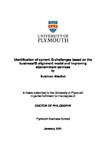Identification of current IS challenges based on the business/IS alignment model and improving eGovernment services
| dc.contributor.supervisor | Liu, Shaofeng | |
| dc.contributor.author | Alfadhel, Sulaiman | |
| dc.contributor.other | Plymouth Business School | en_US |
| dc.date.accessioned | 2021-03-17T15:39:57Z | |
| dc.date.available | 2021-03-17T15:39:57Z | |
| dc.date.issued | 2021 | |
| dc.identifier | 10510883 | en_US |
| dc.identifier.uri | http://hdl.handle.net/10026.1/16951 | |
| dc.description.abstract |
Information systems (IS) are currently used in various units of the eGovernment sector in order to improve the efficiency, quality, usefulness, rapidity and convenience of their services or products. However, not all governments are able to benefit from the full advantages of IS development due to a lack of alignment between the IS department and other agencies in the eGovernment sector. There is no common framework or model that can be applied globally. Each country develops its own eGovernment programmes based on its needs and other national considerations such as political, economic, cultural and social factors. The literature indicates that eGovernment adoption, uses and development have been considered extensively from the viewpoints of the organization and technical issues. However, there is a need for further investigation to inspect how eGovernment agencies can be aligned so that the efficiency of their services can be improved. A strong alignment not only assists any government in improving the performance of its services, but it also enhances public trust in the government’s services. The concept of alignment is not new, first emerging in the 1970s. Since then, researchers and practitioners have studied the process of alignment in the context of organizational strategic alignment, structural and business goals alignment. This thesis proposes an ideal pattern of alignment for the eGovernment sector in the Kingdom of Saudi Arabia and proposes modelling IS requirements as a suitable solution for strong alignment. The ideal pattern of alignment consists of strategic, structural, social and cultural alignment between the IS department and other agencies in the eGovernment sector. The study uses a mixed (qualitative and quantitative) method approach to validate the proposed ideal pattern of alignment. For the qualitative study, initially the factors affecting the ideal pattern of alignment are extracted from the literature and validated by the eGovernment experts. The qualitative data were collected from 20 eGovernment experts from different eGovernment sectors in the Kingdom of Saudi Arabia. The thematic analysis approach is identified as a suitable approach to analyse qualitative data. For the quantitative study, the questionnaire was posted online and possible participants were contacted in the Saudi ministry. The data were collected from 200 eGovernment users in Saudi Arabia. To analyse the quantitative data, confirmatory factor analysis and structural equation model approaches are used. At the process modelling phase, a case study on patient visits to a healthcare clinic is used to validate the method of modelling IS requirements in the context of eGovernment alignment. The study results indicate: 1) if the eGovernment sector in Saudi Arabia is aligned through this ideal pattern of alignment, improved eGovernment performance and enhanced public trust can be achieved; 2) the eGovernment sector in Saudi Arabia can improve its internal and external relations by focusing on the ideal pattern of alignment; 3) modelling and analysing the government environment have a positive impact on the implementation of IS which meets the needs of the government and consequently positively affects the process of alignment. | en_US |
| dc.language.iso | en | |
| dc.publisher | University of Plymouth | |
| dc.subject | Information system (IS) alignment | en_US |
| dc.subject | Business alignment | |
| dc.subject | eGovernment | |
| dc.subject | Goal modelling | |
| dc.subject | Ideal pattern | |
| dc.subject.classification | PhD | en_US |
| dc.title | Identification of current IS challenges based on the business/IS alignment model and improving eGovernment services | en_US |
| dc.type | Thesis | |
| plymouth.version | publishable | en_US |
| dc.identifier.doi | http://dx.doi.org/10.24382/985 | |
| dc.identifier.doi | http://dx.doi.org/10.24382/985 | |
| dc.rights.embargoperiod | No embargo | en_US |
| dc.type.qualification | Doctorate | en_US |
| rioxxterms.version | NA |
Files in this item
This item appears in the following Collection(s)
-
01 Research Theses Main Collection
Research Theses Main


